You may not find this terribly rewarding unless you're included here, so this is a good time for casual and random browsers to turn back before they get too caught up in the sweep and majesty of the proceedings and can't let go.
We're not based in Europe anymore, and we've struggled through the covid-19 lockdowns like everyone else, so we haven't set foot in Italy since February 2019. Now we're making up for lost time with mad sightseeing, but missing the cats even more sorely as the days fly by.
Ascoli Piceno: to the Roman bridge, and then the crypt
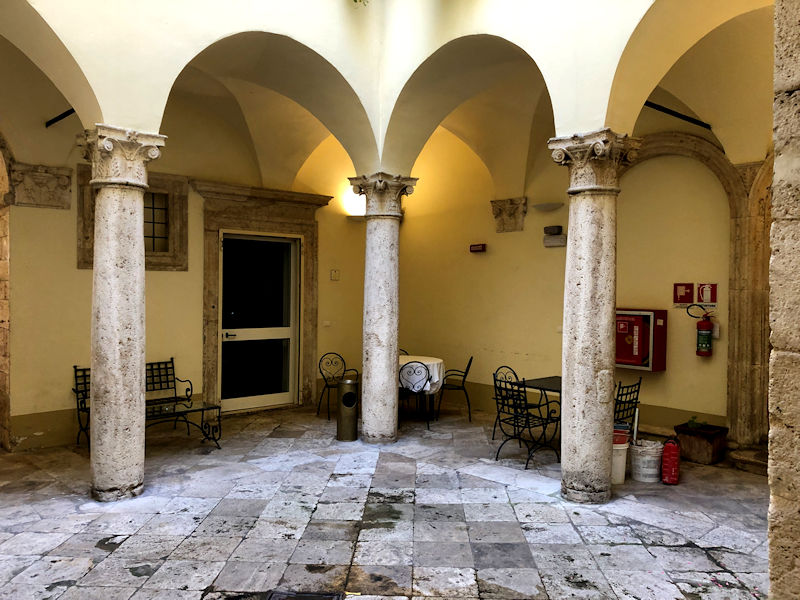
We're off again -- that's our wonderful breakfast room in the central courtyard (there used to be a restaurant there, but no more).
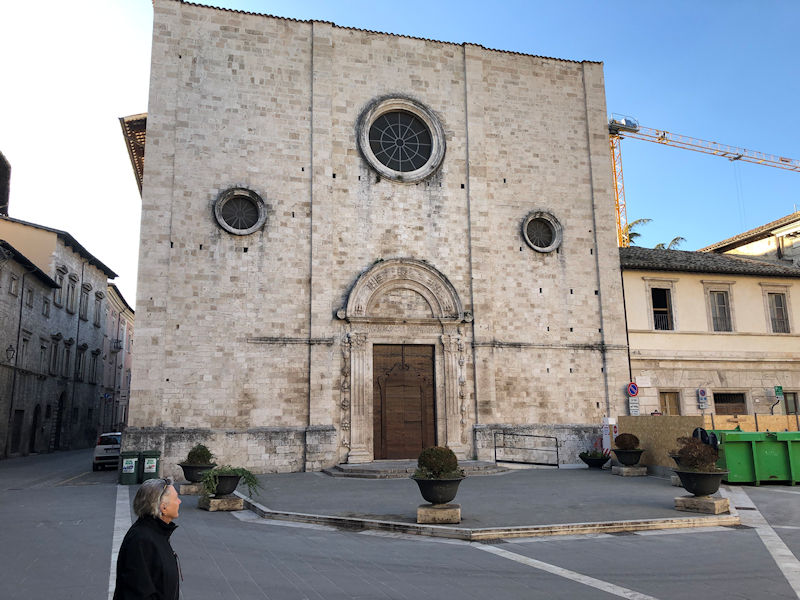
We're walking north towards the ancient Roman bridge on the Via delle Torri, the street of towers, past the Chiesa di Sant'Agostino (begun in the 13th century, enlarged throughout the 14th, renovated from 1483 into the 16th century with the new façade). No time for that now, we're on a mission to the Roman bridge.
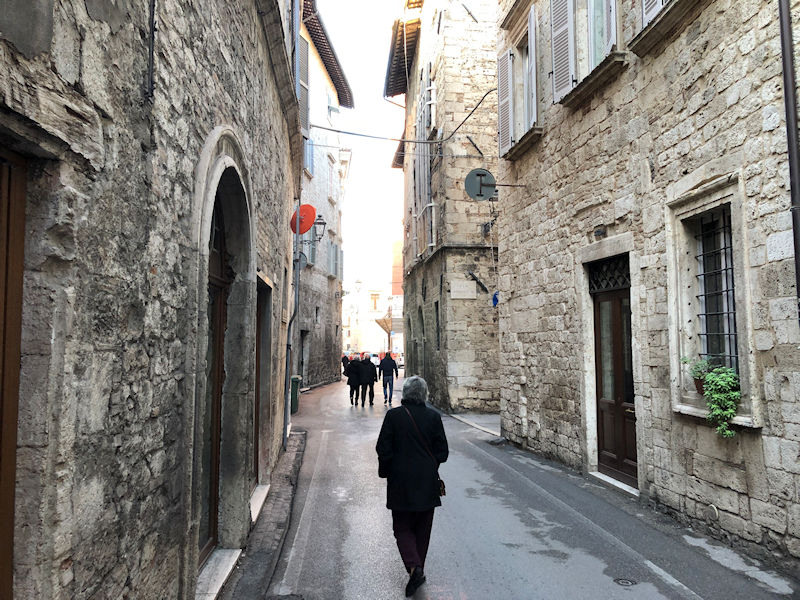
The Via delle Torri (we've just passed the famous Torri Gemelle, the 'twin towers', strolling obliviously under maintenance hoardings protecting us pedestrians from whatever might be falling off the roof).
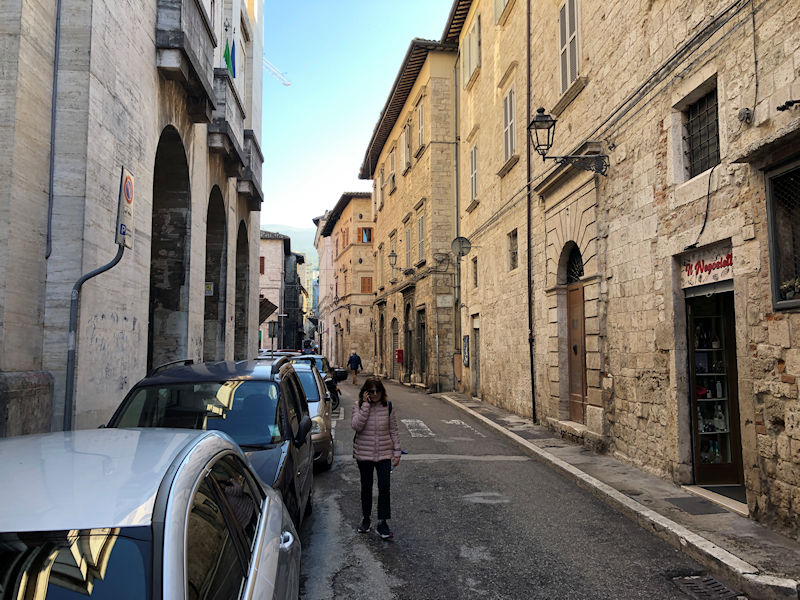
Ascoli street scenes
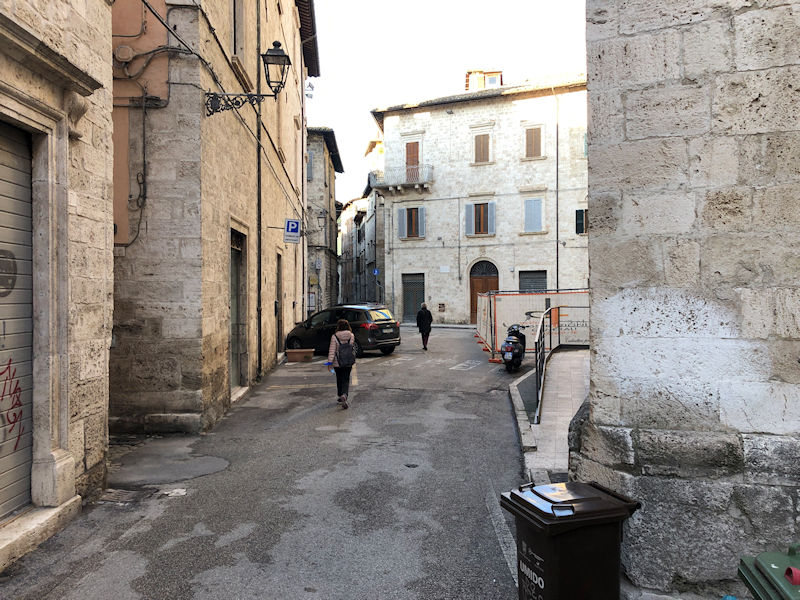
We're just passing the front of the Chiesa di San Pietro Martire on the right, with . . .
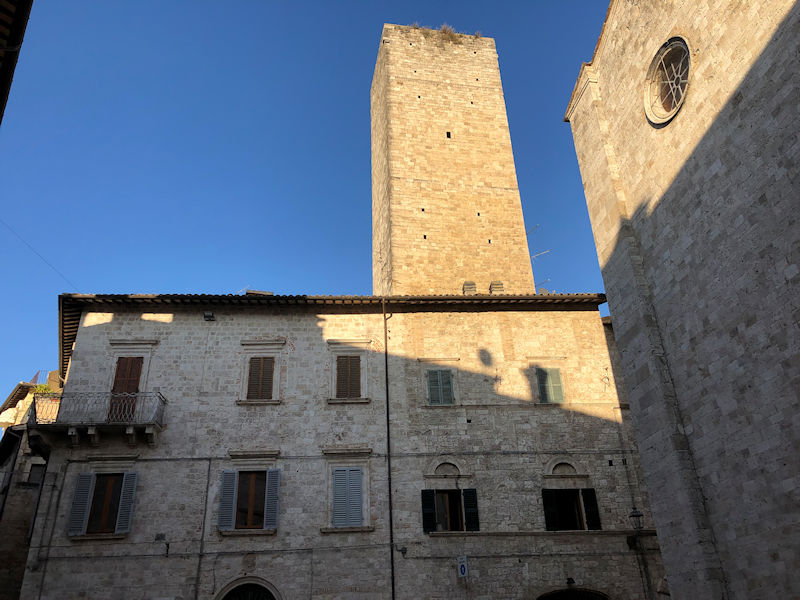
. . . an unnamed tower just before us. With some grass on top.
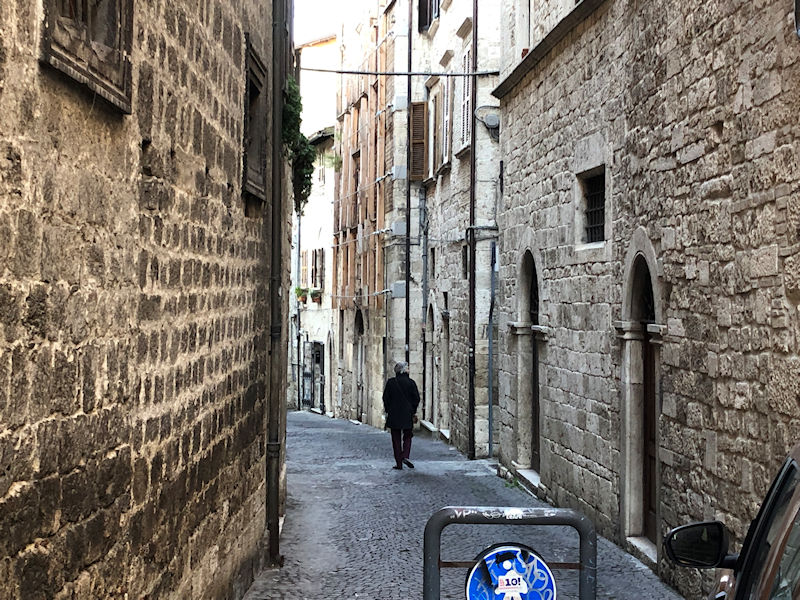
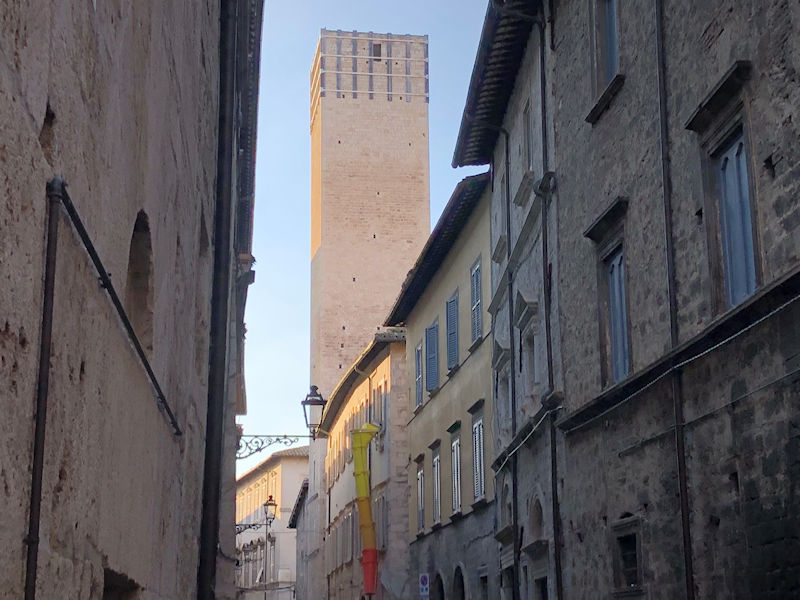
One of these huge things is the Ercolani Tower, attached to the Romanesque Palazzo Longobardo, but we'll make a note to come back to that.
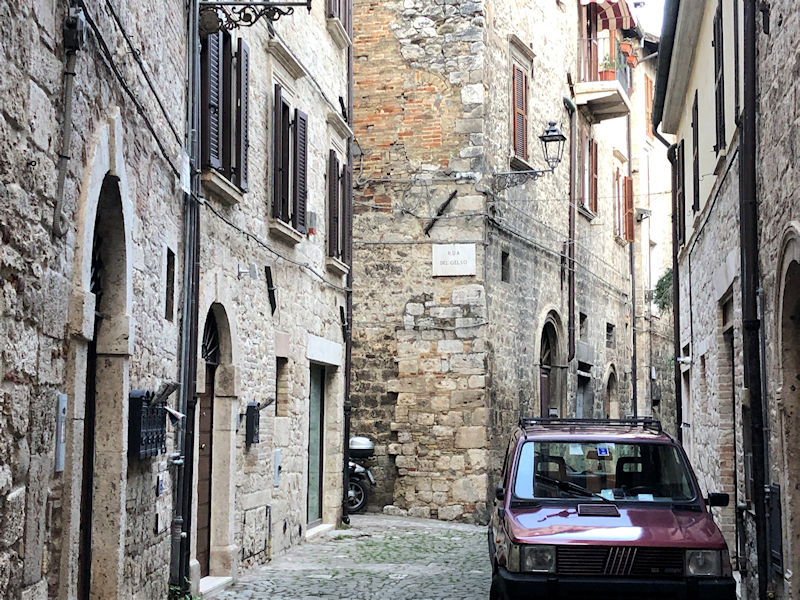
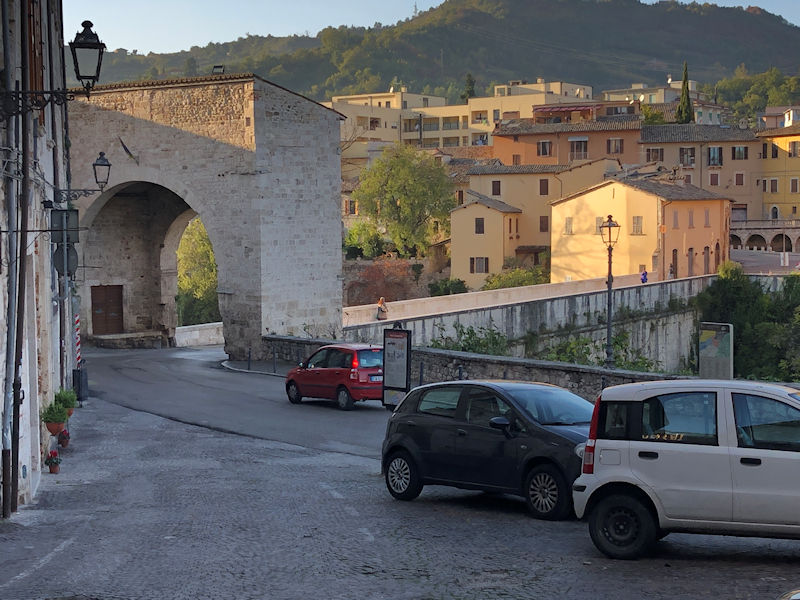
Here's the Roman bridge, called the Ponte di Solestà, with the gateway of the same name. The bridge was built at the direction of the Emperor Augusta to connect imperial interests on both sides of the Tronto river, constructed using large blocks of the local travertine stone that characterizes most of the older buildings in town. Restoration and consolidation works were undertaken in the earlier 20th century.
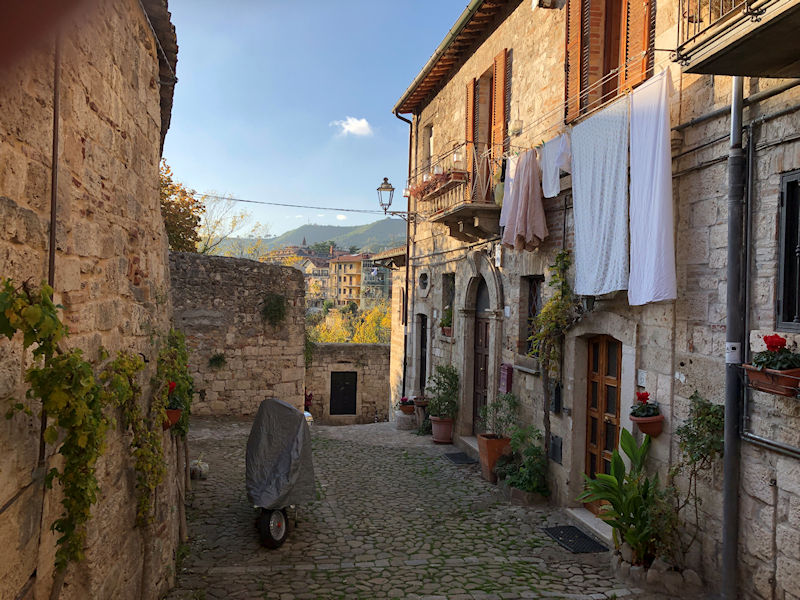
A little picturesque diversion round behind the gateway
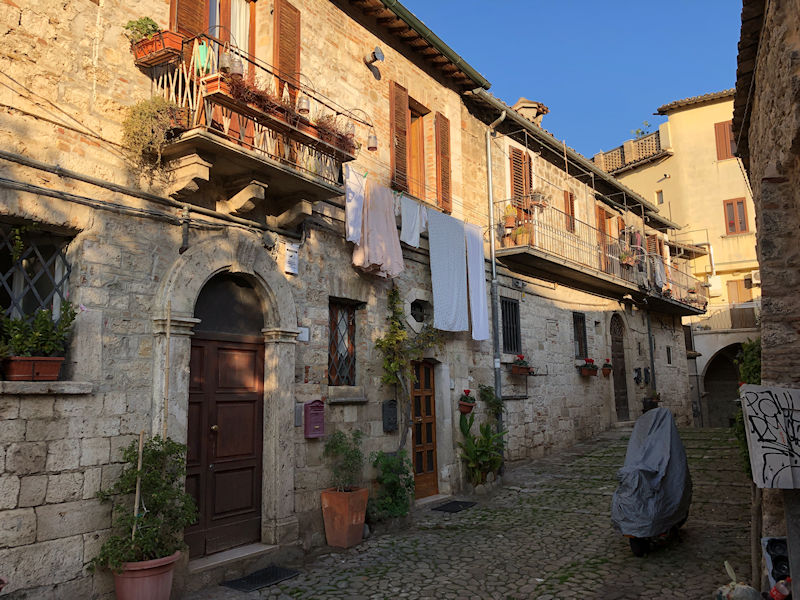
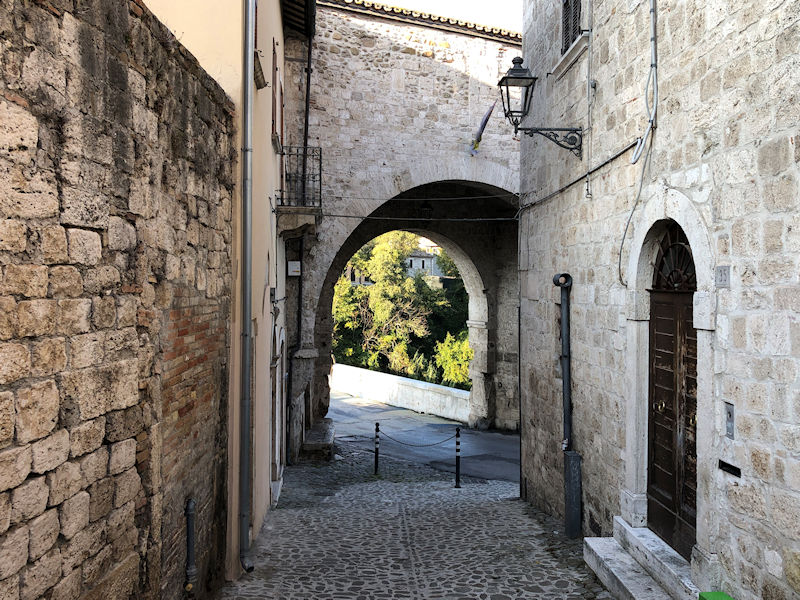
And back down to the bridge and to its venerable gateway, built in 1230 by the then-podestà, Fildesmilio da Mogliano. (The podesta in many cities during the unruly commune era of the late 12th and 13th centuries was normally an external and unbiased officer hired to serve as the chief judicial and military magistrate of the municipality, usually for a limited term like one year.)
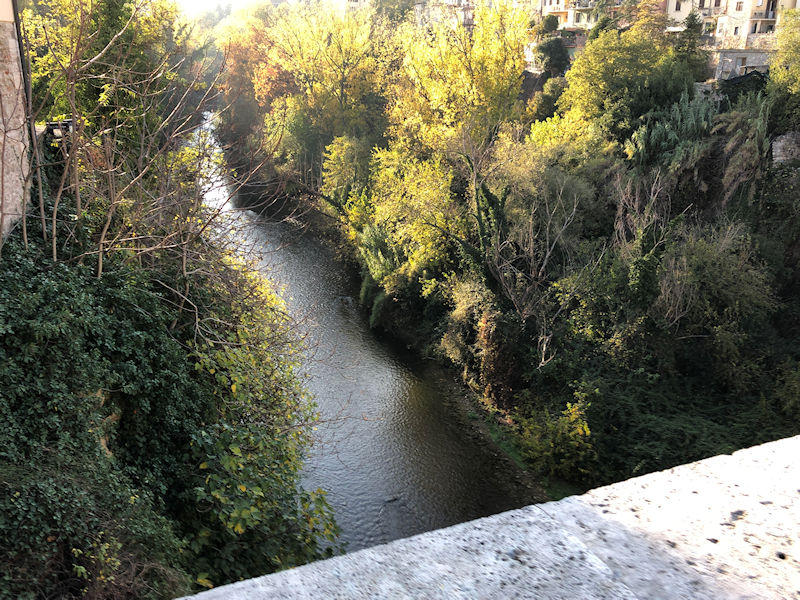
The mighty River Tronto
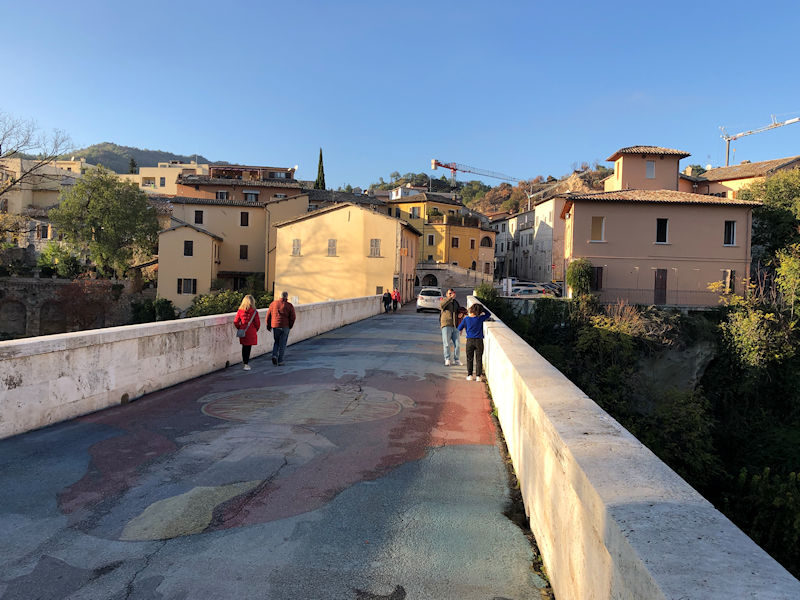
The suburb on the far side of the river, called the Sestiere Porta Solestà
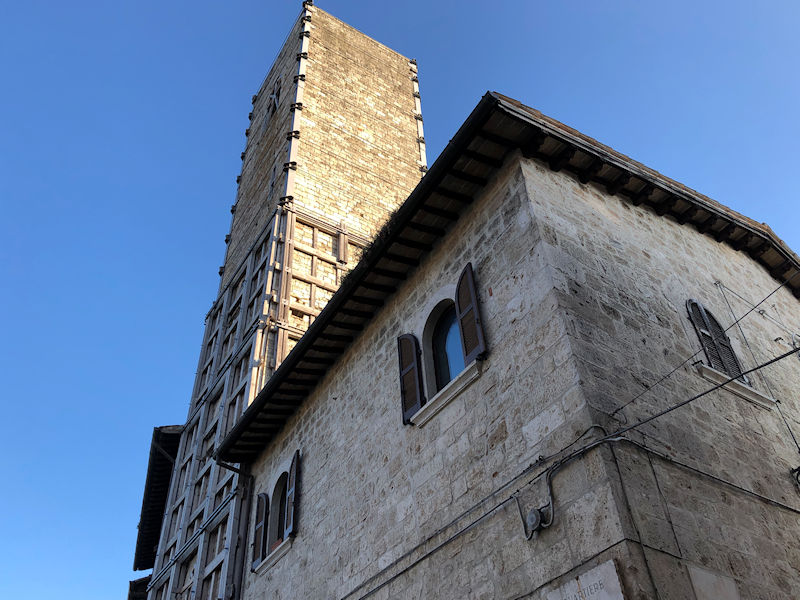
Here, overlooking the bridge from the near side, is the Torre dei Novelli, or perhaps Grisanti, but apparently in fact no one knows what family built the thing, or when. It's been conjectured that it was put up in the late 11th or early 12th century, based on construction similarities with the Sant'Emidio Cathedral and the Tower of Ercolani.
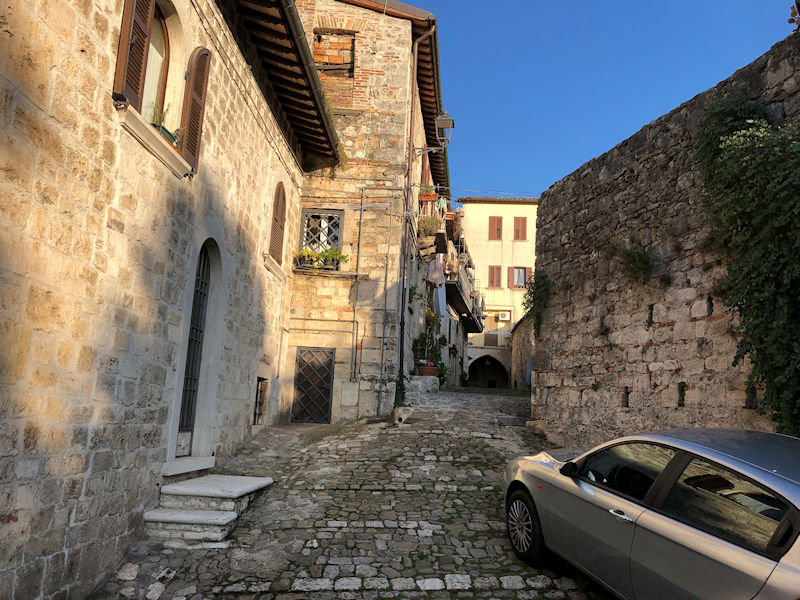
We are now going to proceed along the Rua delle Stelle, named for the small 'Mary of the Stars' church built nearby in 1586 to house an icon of the Madonna of Loreto painted on the town walls. 'Rua' is the local name for a small lane, but this one is also called the 'Rrete li Mierghie' because it goes just behind what were the city walls, which had defensive merlons (here called 'mierghie') on them in the past.
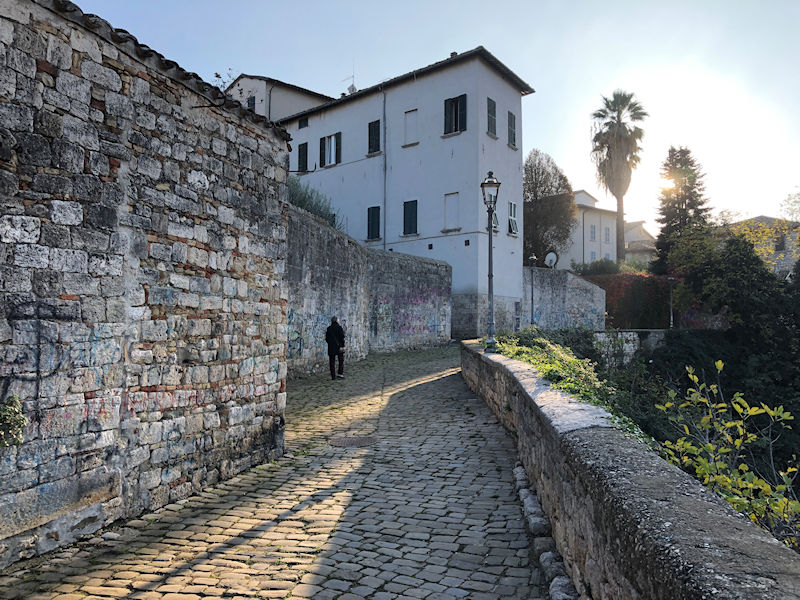
The Rua delle Stelle, going westward above the river, towards the western city gate, the Porta Romana

The small suburb across the river
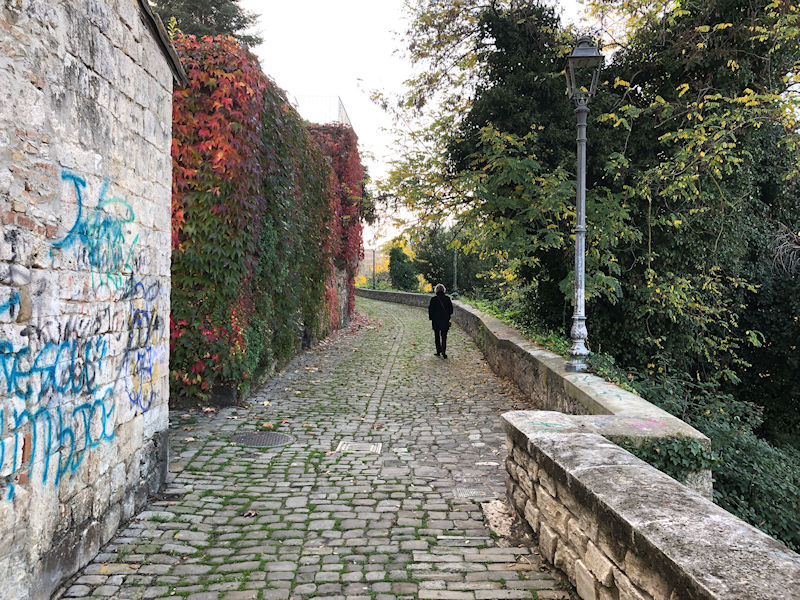

Soon passing the negligible eponymous little church and . . .
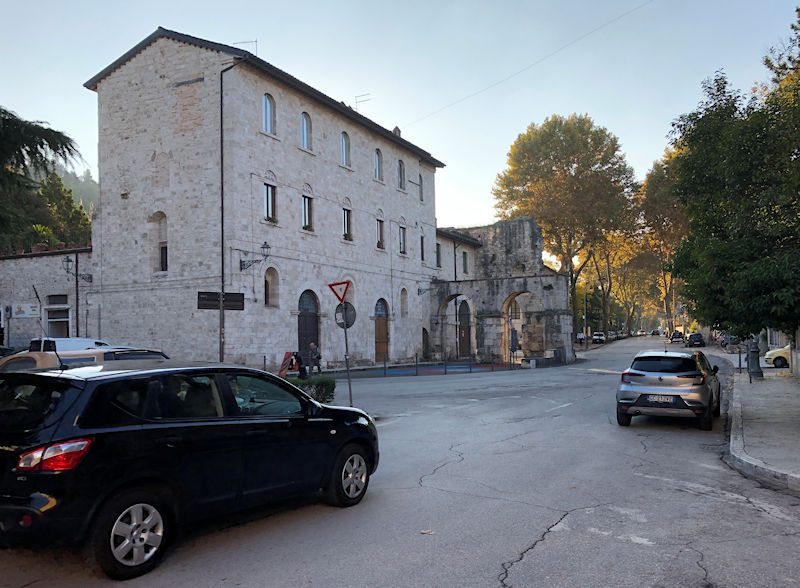
. . . popping out near the ruins of the Roman Porta Gemina ('twin gates'), with the later Porta Romana just beyond it. We'll come along for a better look at it another day.
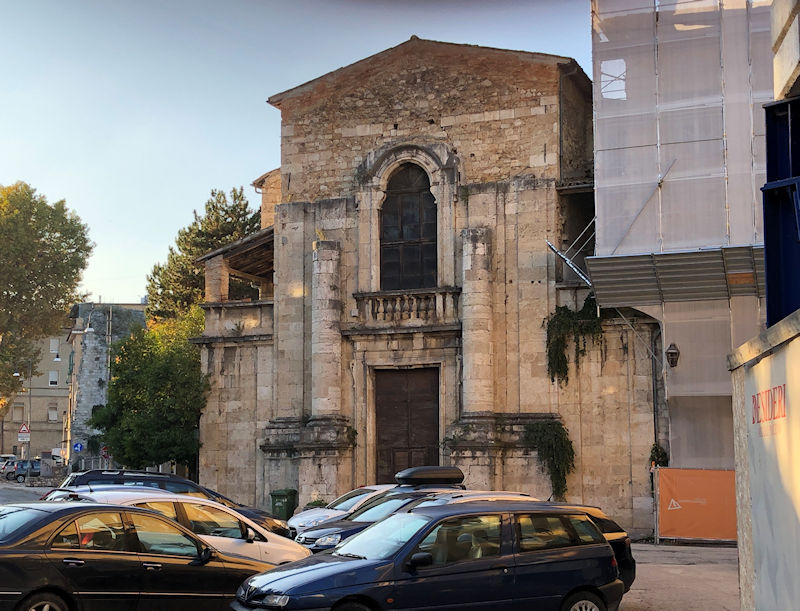
Across the Corso Mazzini, this is called the 'Auditorium San Leonardo', evidently finally getting some salutary restoration works.
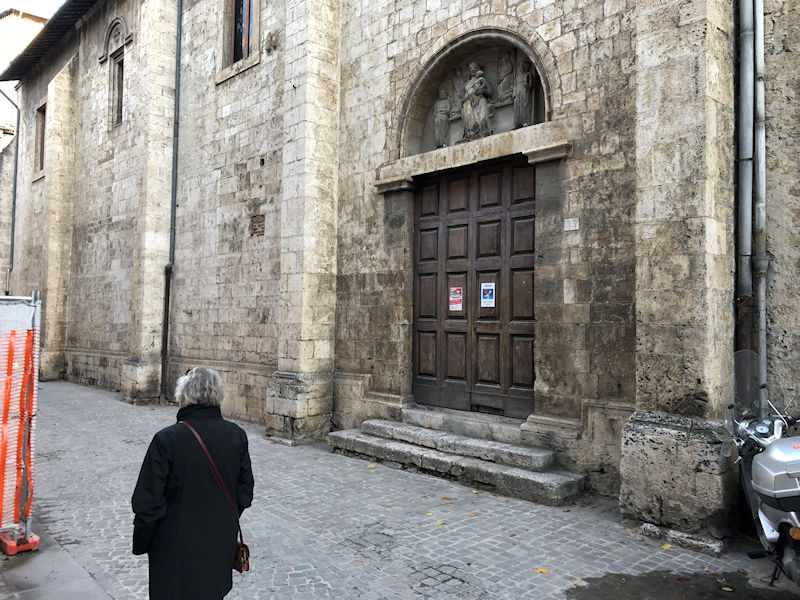
Back towards the town centre on the Corso Mazzini, we're passing the Chiesa di S. Andrea. The relief of the enthroned Madonna in the lunette is said to be from the 14th century.
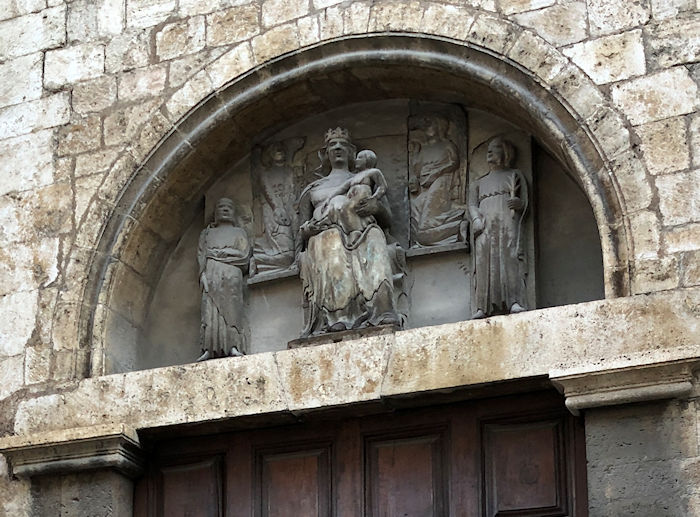

The same church, a bit farther along
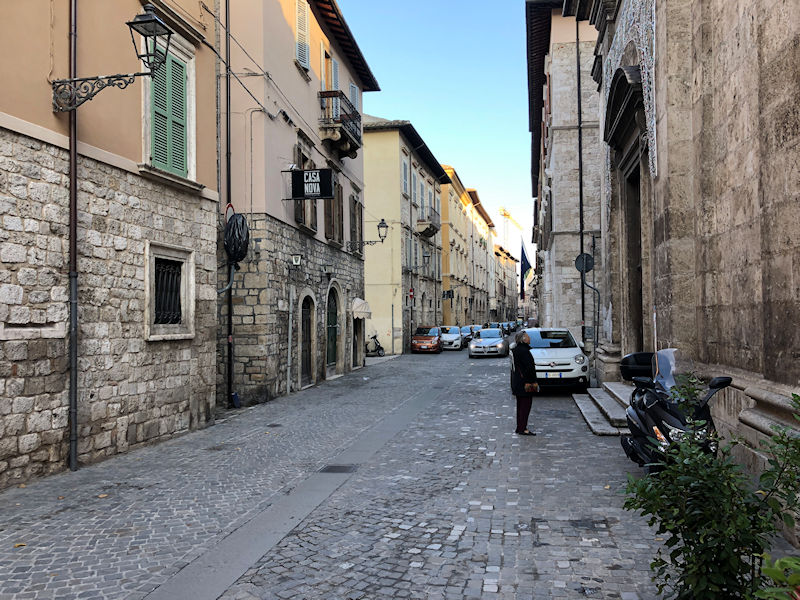
Admiring the Madonna lunette
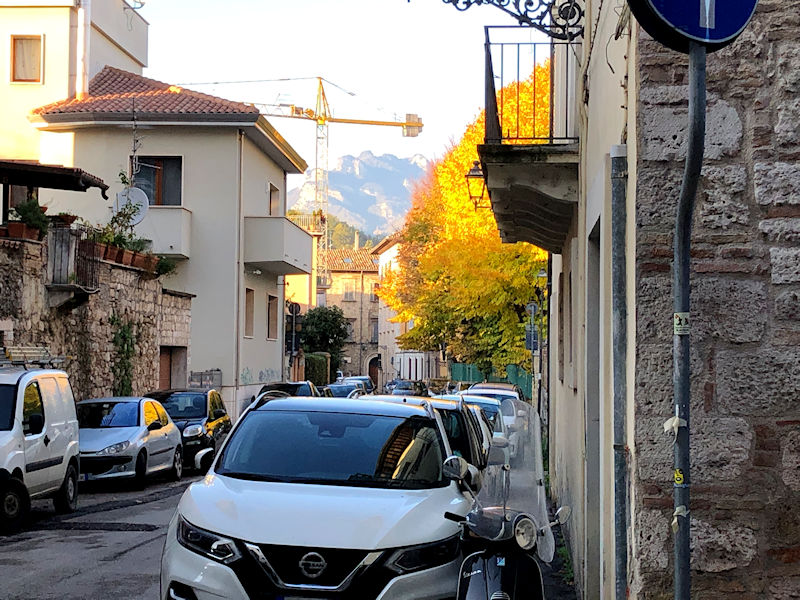
Corso G. Mazzini street scene
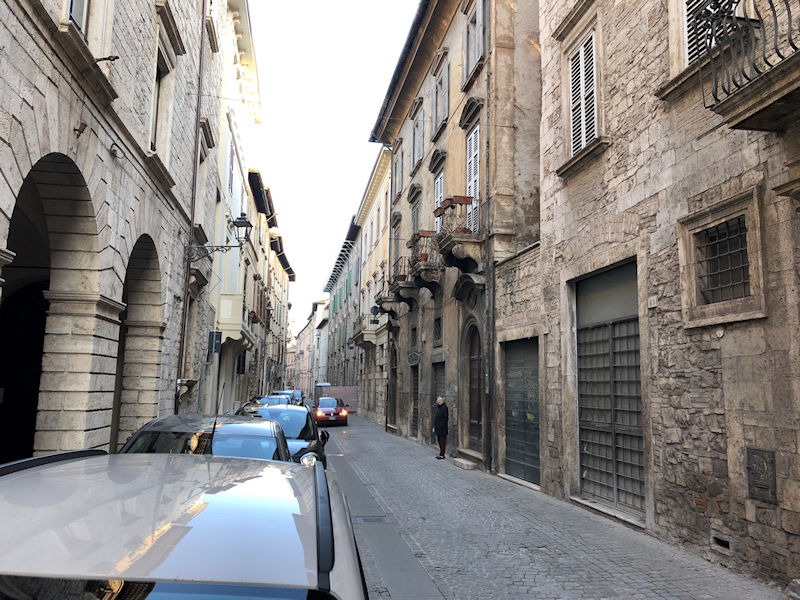
Ditto
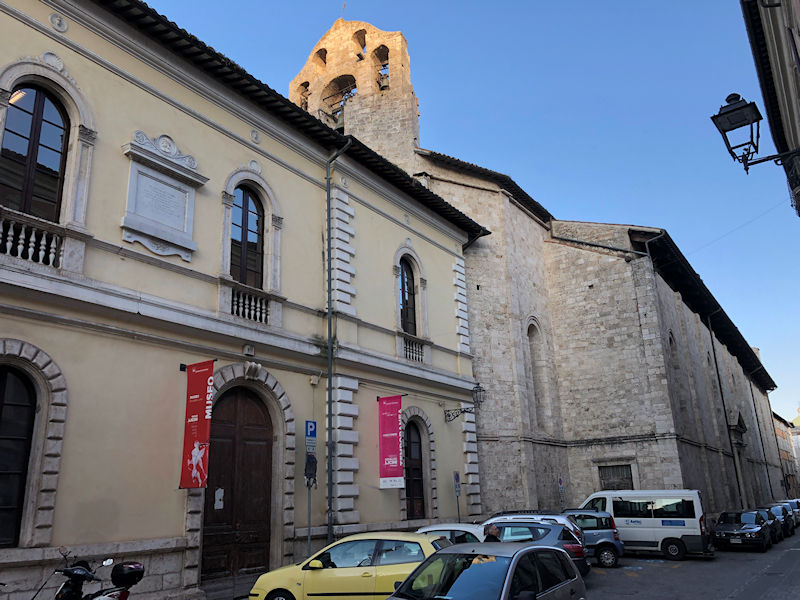
Arriving at the back end of the St Augustine church, the front of which is seen at the top of this page. The whole establishment is much more elaborate than it seemed at first, including the Galleria d'Arte Contemporanea 'O. Licini' and the Polo Culturale ('cultural centre') Sant'Agostino.
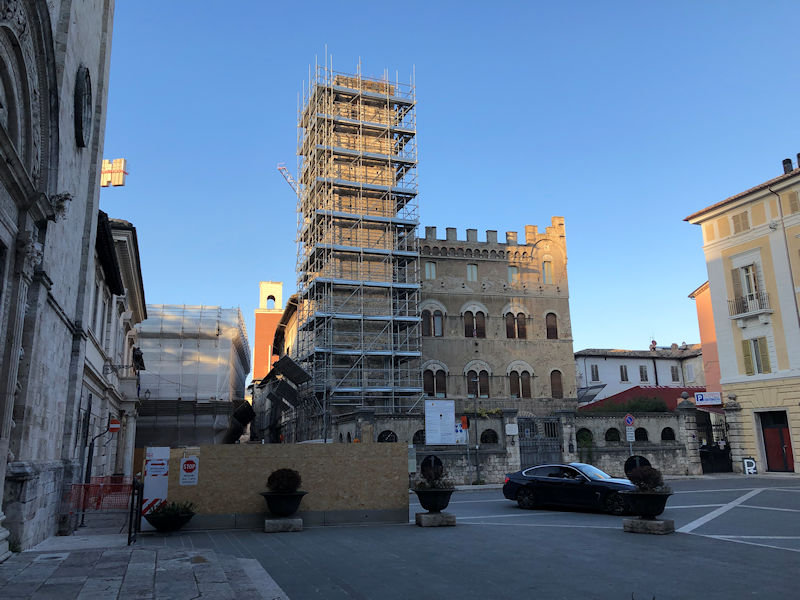
And there, from the front door of the Chiesa di Sant'Agostino, is the famous Torri Gemelle that we entirely missed earlier today, built in the 12th century of the travertine ashlars nearly ubiquitous in Ascoli. The Merli family bought the two towers in 1885 and added them to their mid-19th century Palazzo Merli, facing onto the Via delle Torri, and added the Medieval Revival façade facing us now onto the Piazza Sant'Angelo in 1927.
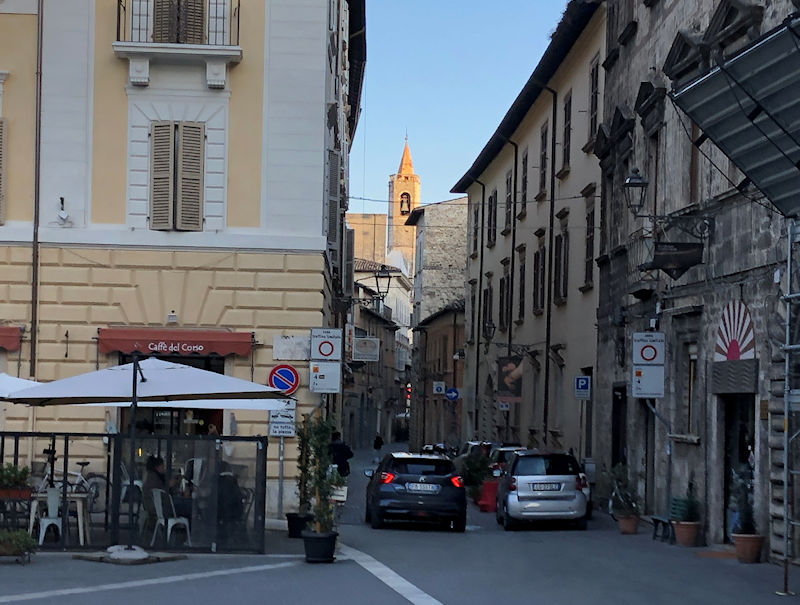
That's looking farther along the Mazzini Corso towards the Piazza del Popolo, but we're turning left now, back down the Via delle Torri.
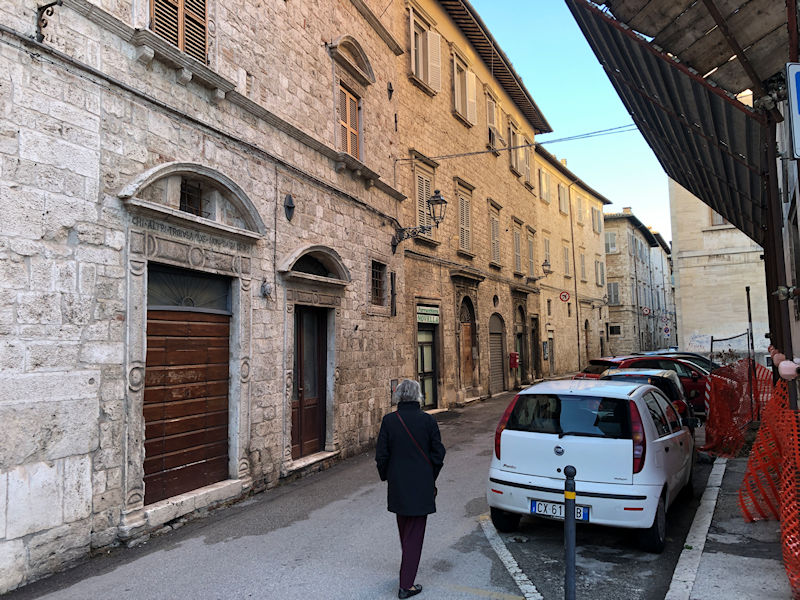
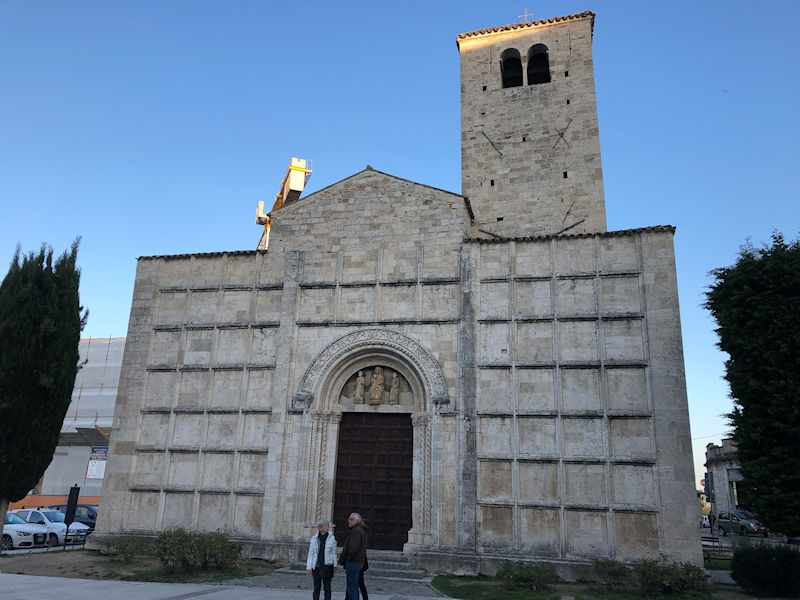
That's the Chiesa dei Santi Vincenzo e Anastasio, in the Piazza Ventidio Basso, a Romanesque church built in the 11th century and enlarged in 1389, with a portal from the early 15th century, and with a pre-existing crypt from the 6th century. The panels on the façade originally held frescoes. We're informed that it's normally very difficult to get to see the inside of it. (The piazza is named for Ventidio Basso, a native of Ascoli who became one of Marc Antony's chief lieutenants, especially during the Parthian campaigns of 39-38 BC, for which he was honored with a triumph.)
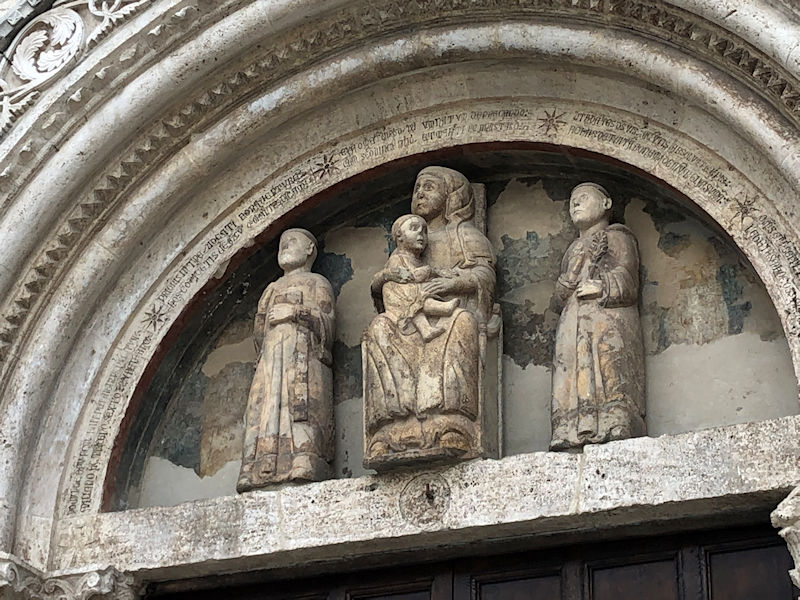
That's the 14th century embellishment in the tympanum.
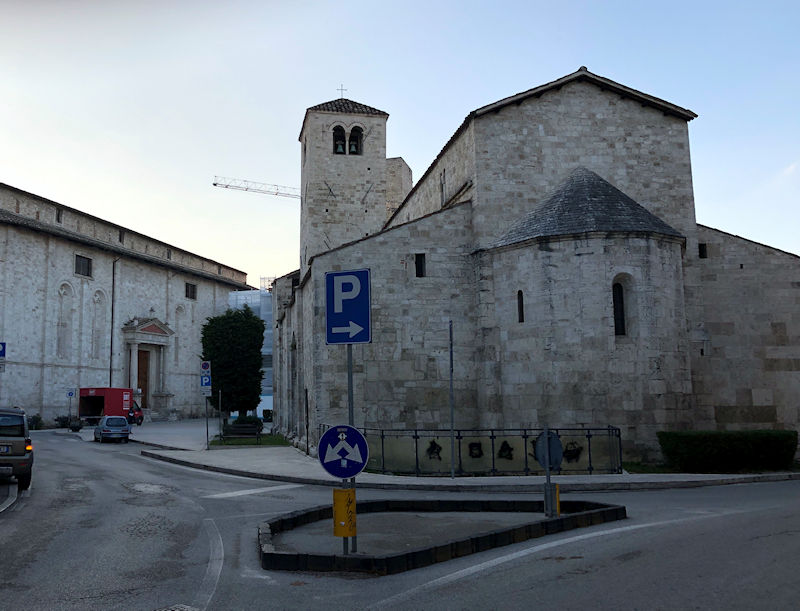
The back of the Vincenzo e Anastasio church, where the two wings of the Piazza Ventidio Basso rejoin and move on to the Via E Tamburini.
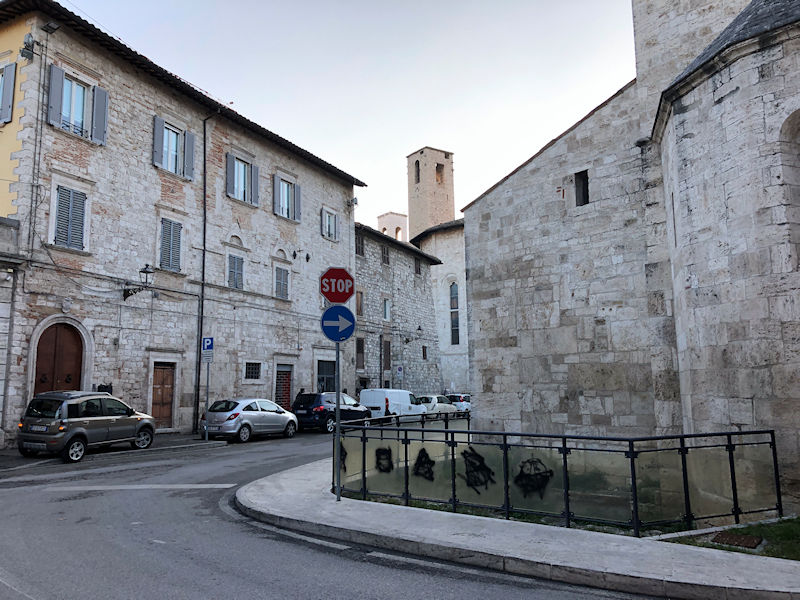
Looking past the Vincenzo e Anastasio, that's the belltower of the Chiesa di San Pietro Martire looming.
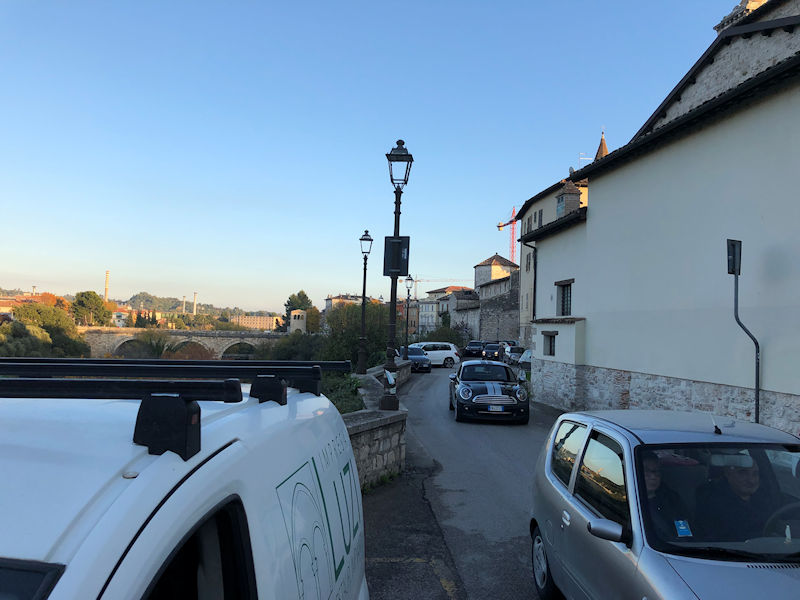
The Via E Tamburini overlooking the river (the Ponte Nuovo can be seen over the river)

[Failed to identify this one, alas, but it's nice.]
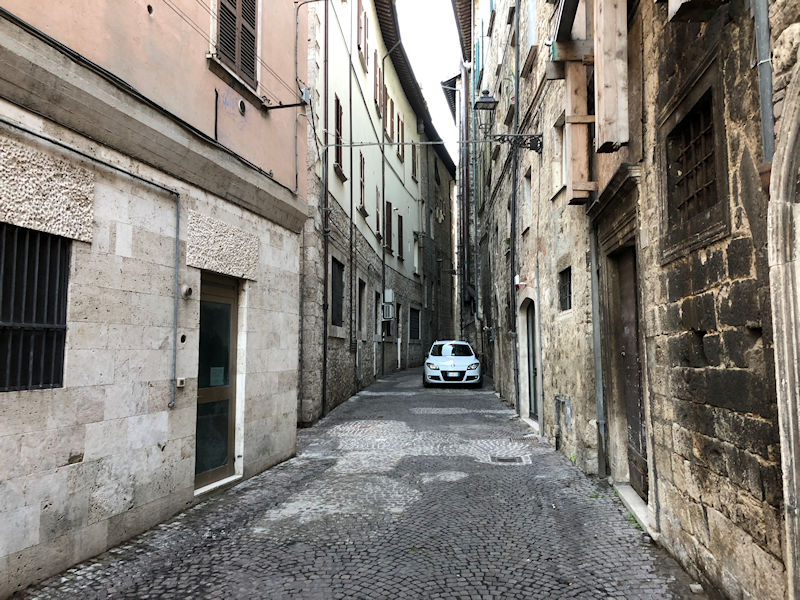
Lost in the alleyways
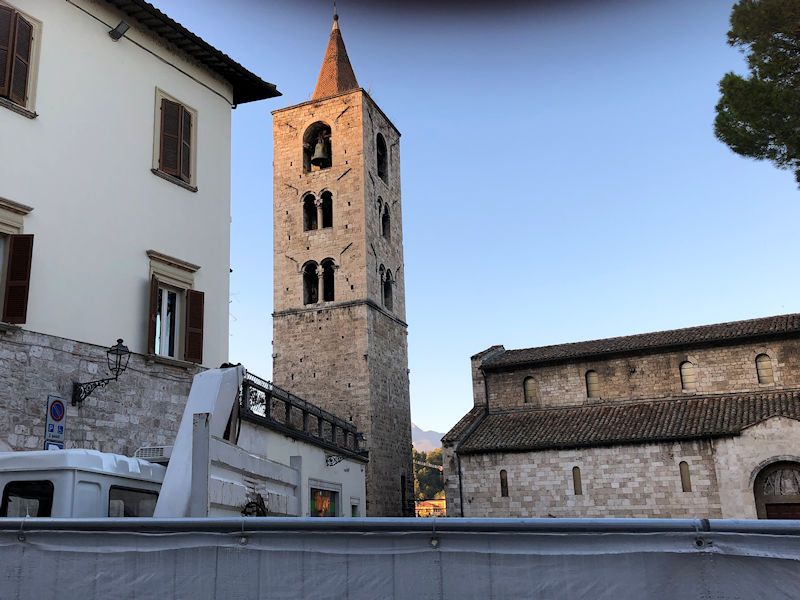
The Chiesa Santa Maria Inter Vineas on the river road, seen from behind the current roadworks on the Corso Trento e Trieste.
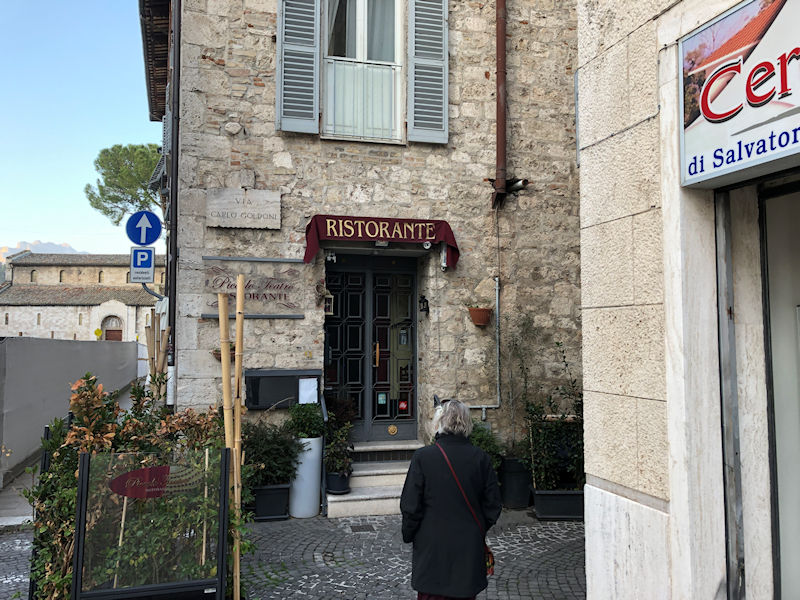
Along the Corso Trento e Trieste, the Ristorante Piccolo Teatro, facing onto the Via Carlo Goldoni (we'll be back!)
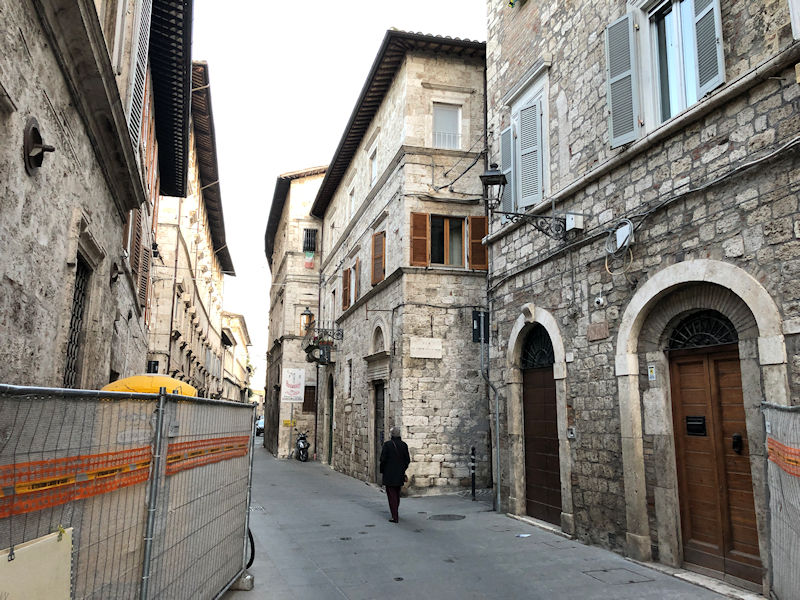
We've somehow wandered back up to the Corso Mazzini through-street, approaching the enormous Palazzo Malaspina . . .
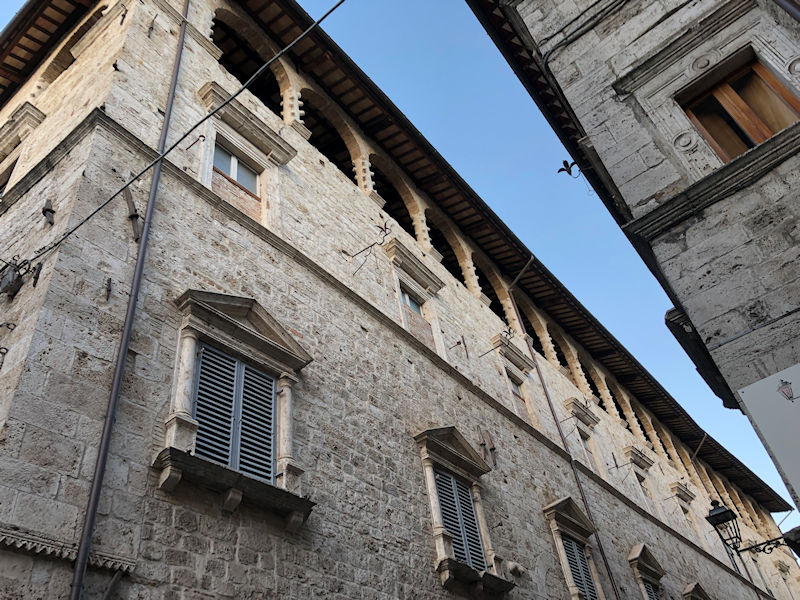
. . . a 16th century monster built by joining a number of 14th century buildings, like many of the palazzi along this stretch of the Corso Mazzini. This was formerly the home of the city's Galleria d'Arte Contemporanea from its founding in 1964 until its transfer to the Sant'Agostino cultural centre. The loggia on the top floor is amazing.
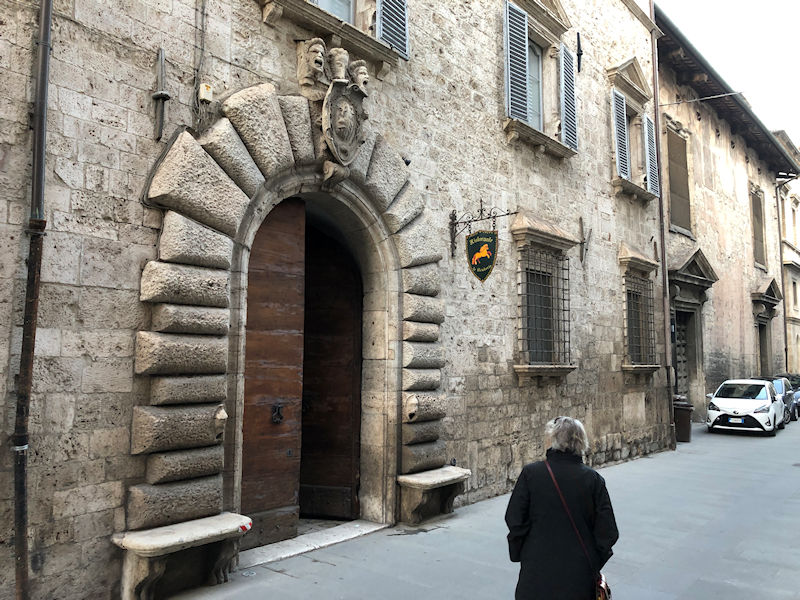
The Ristorante le Scuderie has a nice little sign out; it's highly rated on the Internet, but Google describes it as 'permanently closed'. The two main portals of the Palazzo Malaspina, of which this is one, sport, in addition to the cute little grotesque faces, or 'mascarons', for warding off devils and what not, the coats of arms of the Malaspina and Guiderocchi families, once evidently closely linked.
[The Malaspinas were an enormous family growing from the Obertenghi line of Lombard origin in the 10th century in the Lunigiana, Genoese, and Ligurian region, from the Apennine mountains to the Mediterranean. There were many, many branches of it throughout northwestern Italy, including a marquisate ruling from 1266 to 1797, but only one of the branches is associated with the Marche region here, specifically in Ascoli Piceno. That branch was dispossessed by the Malatesta tyranny in the 14th century, but reinstated by the Sforzas, until their feudal fief was acquired by the papacy in 1502. The Malaspinas seem to have been associated with the silk industry here, and their name is all over Ascoli today, with streets, an elementary school, a carpark, a restaurant and a pasticceria, a tobacconist, and what not, and according to the Italian Wikipedia, the family are presently still in residence in the palazzo.]
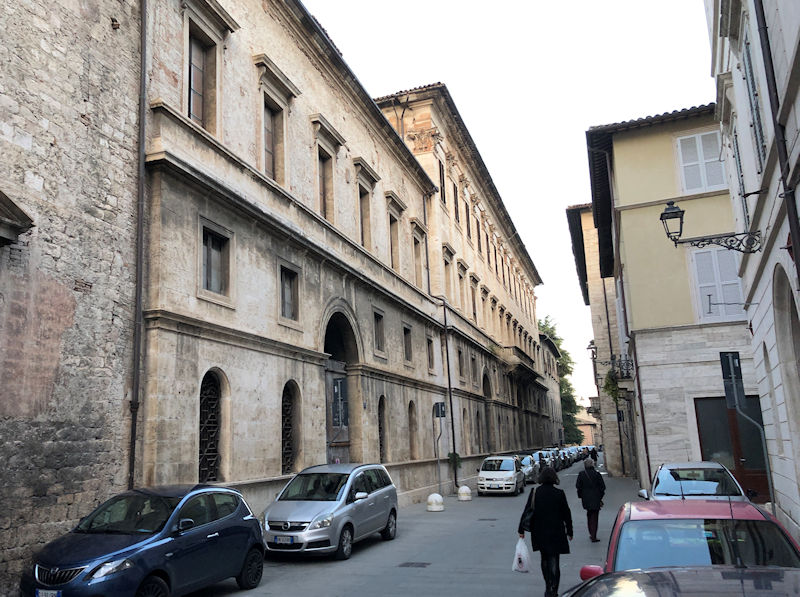
The next palace along the Corso Mazzini is the Palazzo Saladini-Pilastri, built in the 16th century over a former monastery of Benedictine nuns (and we're told that the massive gardens in the back retain remains of the medieval cloister). There's said to have been a 'drastic restoration operation' in 1848. The complex of palace and gardens has recently been purchased by the city and was inaugurated as a site of the FAI, the Fondo Ambiente Italiano (Italian Environment Fund) at the Autumn FAI Days celebration, with 5,000 visitors, in October 2022.
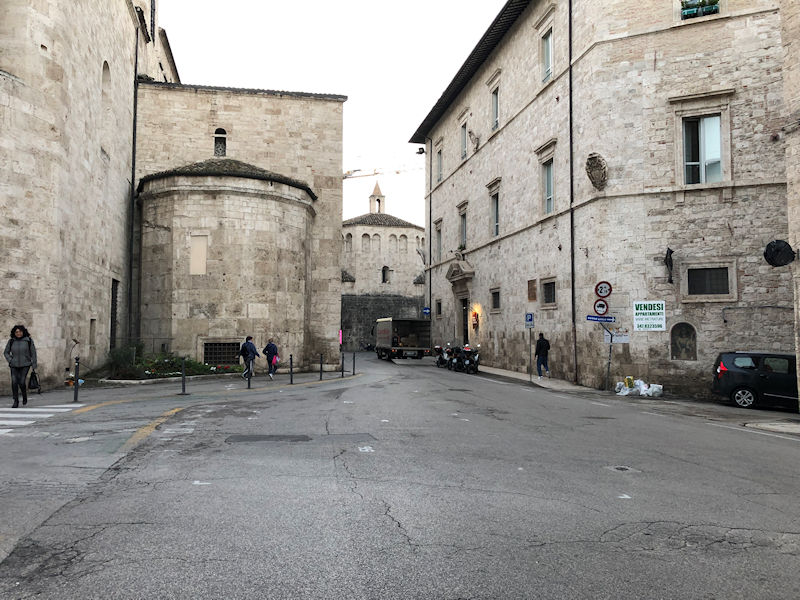
Now, somehow, we've fetched up on the Corso Vittorio Emanuele where it bangs up against the back of the Duomo -- that's the free-standing Baptistry in the centre a little farther on, but we're turning left here onto the Via Dante Alighieri.

Passing along Dante St behind the cathedral complex . . .
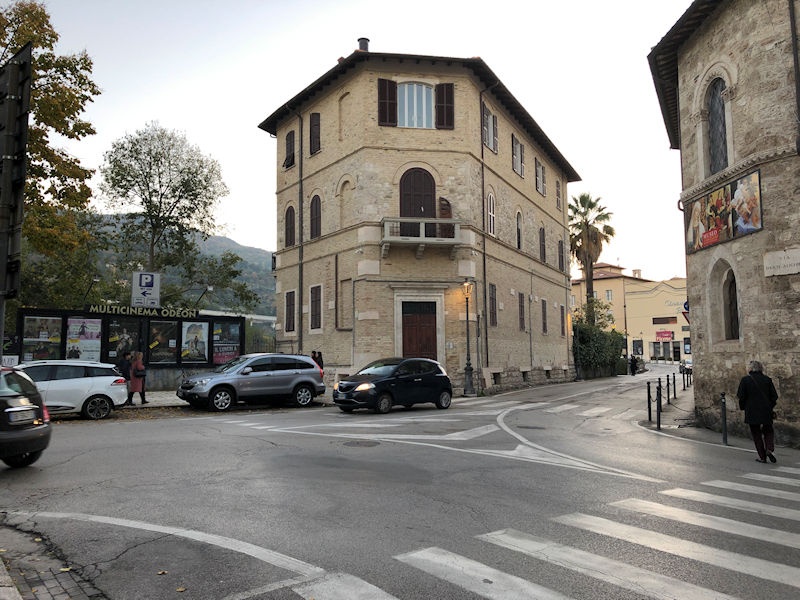
. . . to the Lungo Castellano Sisto V, overlooking the Castellano torrent along the south and east sides of the old town -- we'll be turning in just before the Nuovo Cineteatro Piceno up the street a ways to sneak amongst the bishop's establishments to the front door of the Duomo.
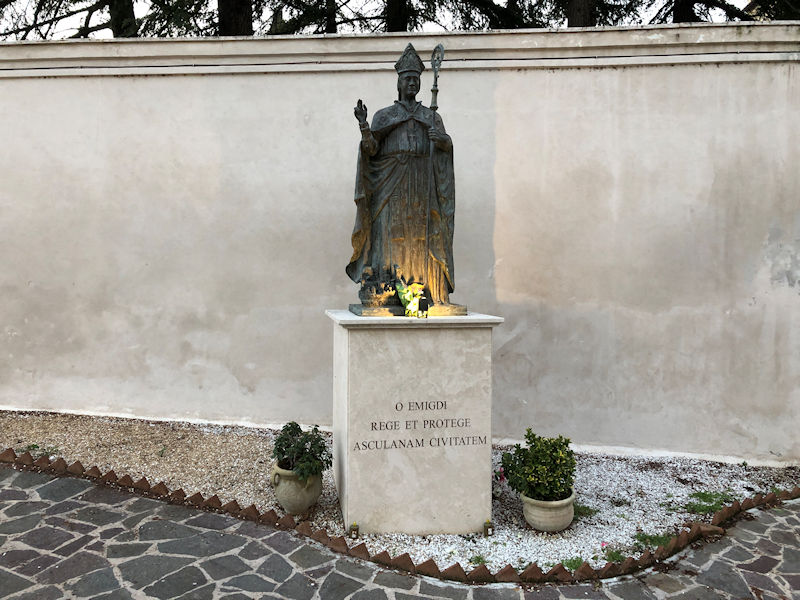
Here, by the episcopal gardens, we'll slip quietly in, with the fervent hope that St Emigdi will continue to rule and protect the City of Asculanum.

Now for the Duomo itsownself . . .
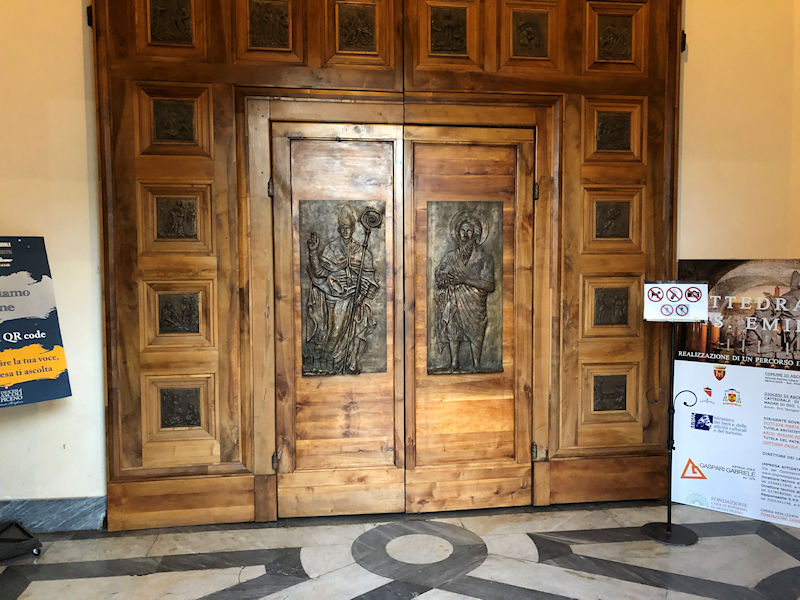
. . . and its fancy front door and . . .
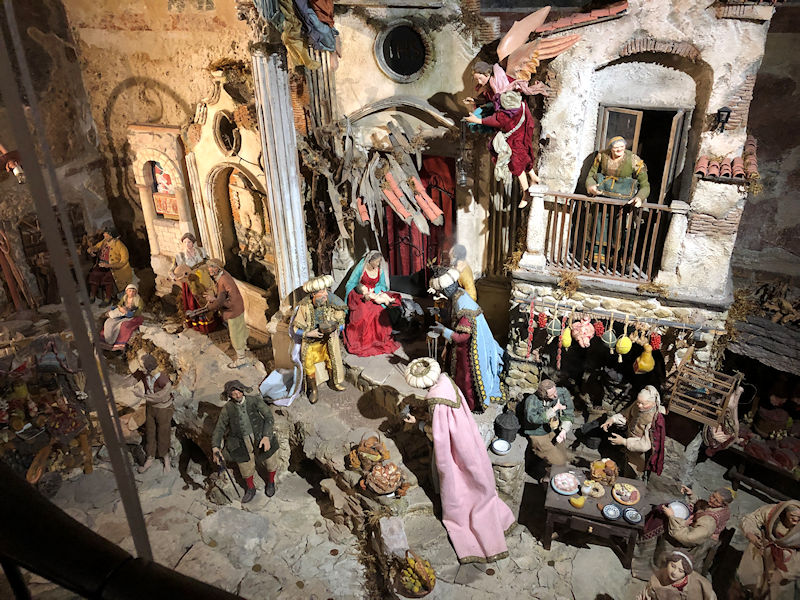
. . . its splendid crèche just inside the door of the porch.
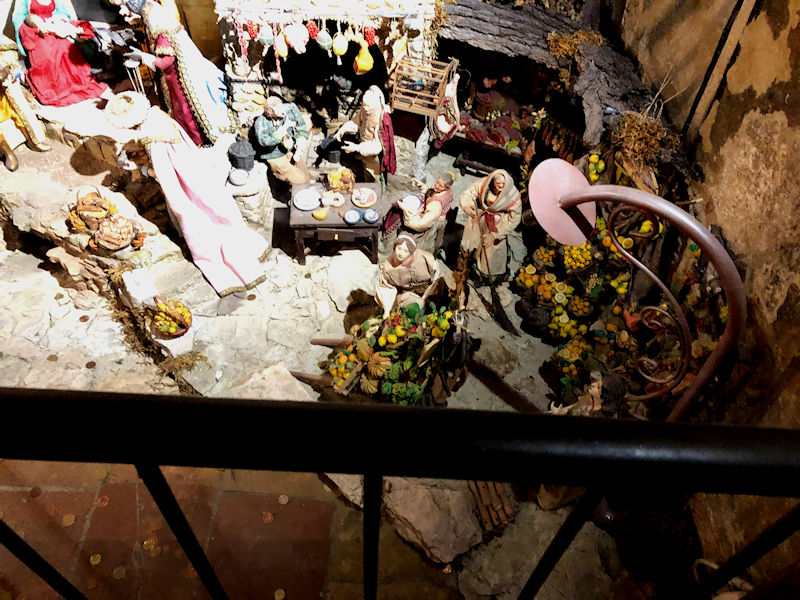
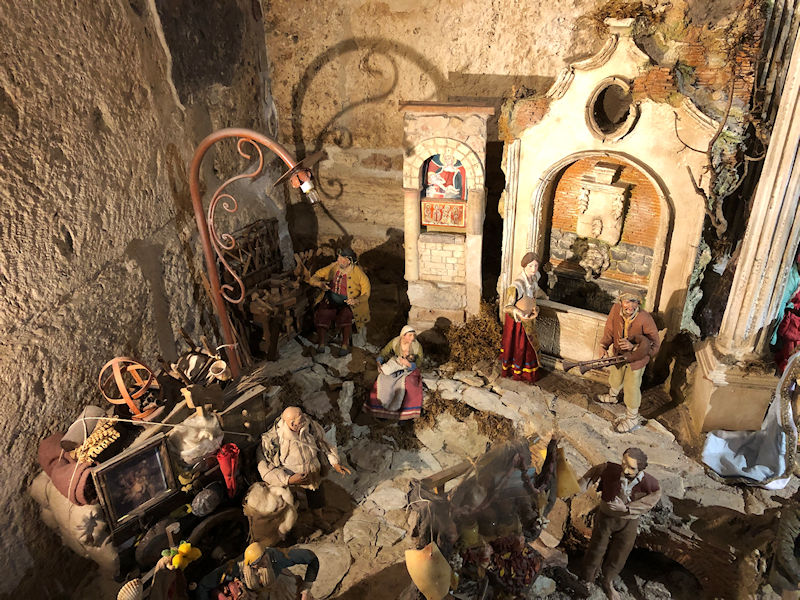
This inspired collection would be a worthy companion to Kristin's artisanal Neapolitan collection at home in Staunton.
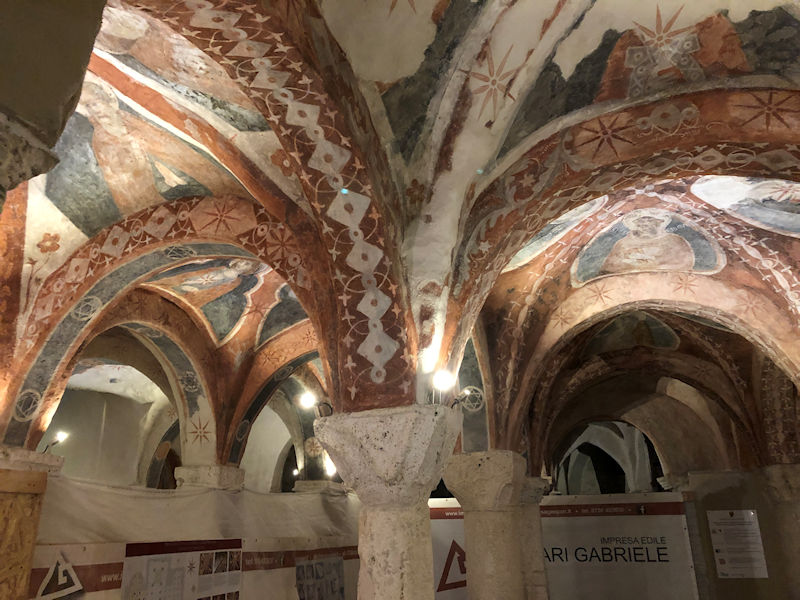
And now for the Crypt!
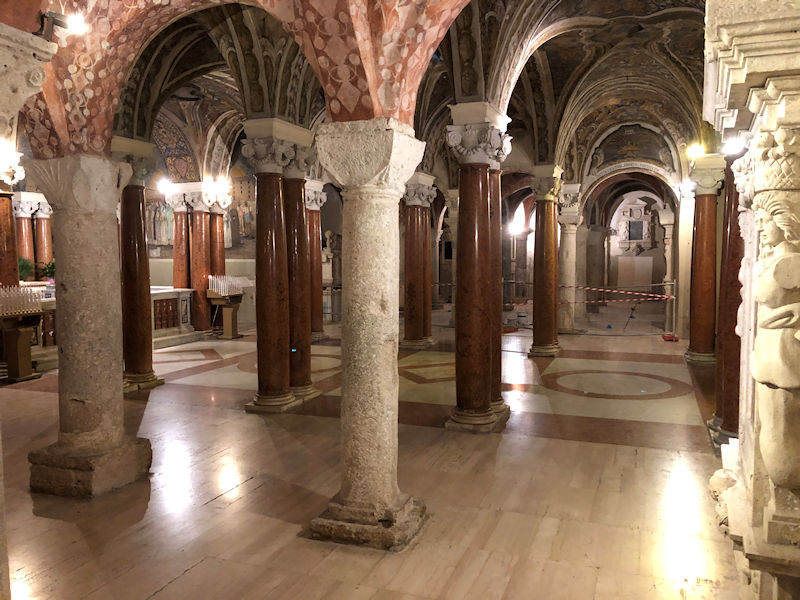
The crypt is said probably to have been built in the mid-11th century in order to host the relics of Sant'Emidio and his friends found in the catacombs of the Campo Parignano just up the hill on the far side of the Ponte Solestà, where there is now the 18th century Tempietto (small temple) of Sant'Emidio alle Grotte. It had to have been completed by 1054, when a papal bull referred to the cathedral as dedicated to the martyr Emidio as well as, as theretofore, to the Virgin.
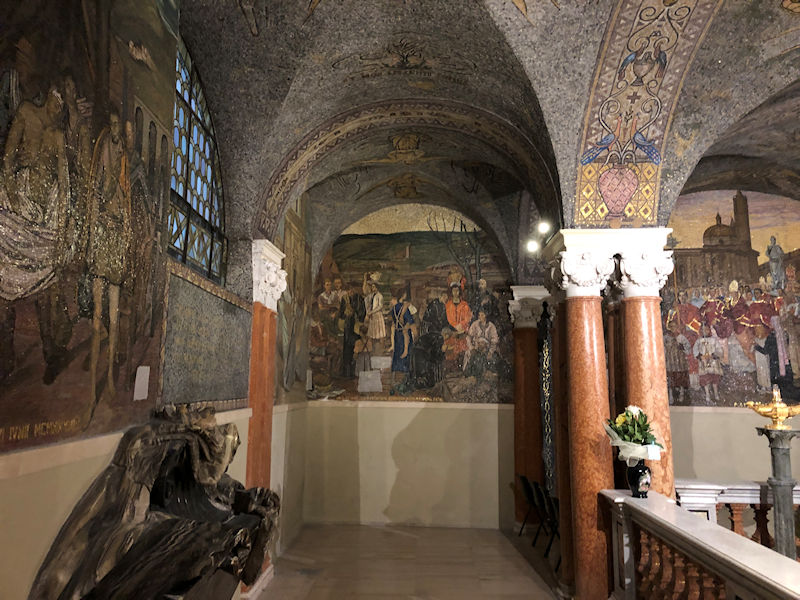
The crypt was remodeled in the early 18th century by Giuseppe Giosafatti, who'd worked for Bernini in Rome, including on the Four Rivers fountain in the Piazza Navona, and . . .
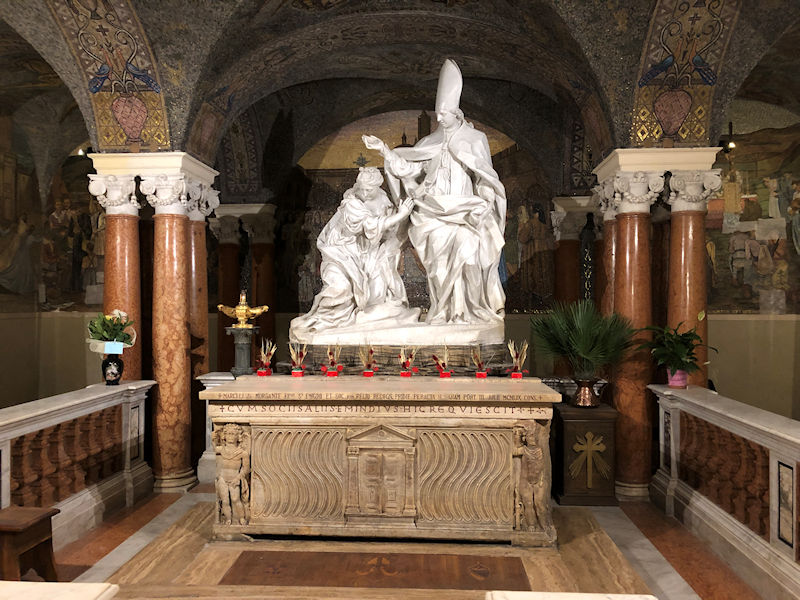
. . . this marble group, showing St Emidio in his demonstrative hat baptizing Polisia, whose father became lethally angry at Emidio in consequence, was made in 1730-1734 by Lazzaro Giosafatti, one of Giuseppe's three sculptor sons. Beneath that is the tomb of Emidio, or rather the tomb of a pagan soldier of the 3rd century, repurposed, with what's left of Emidio in it.
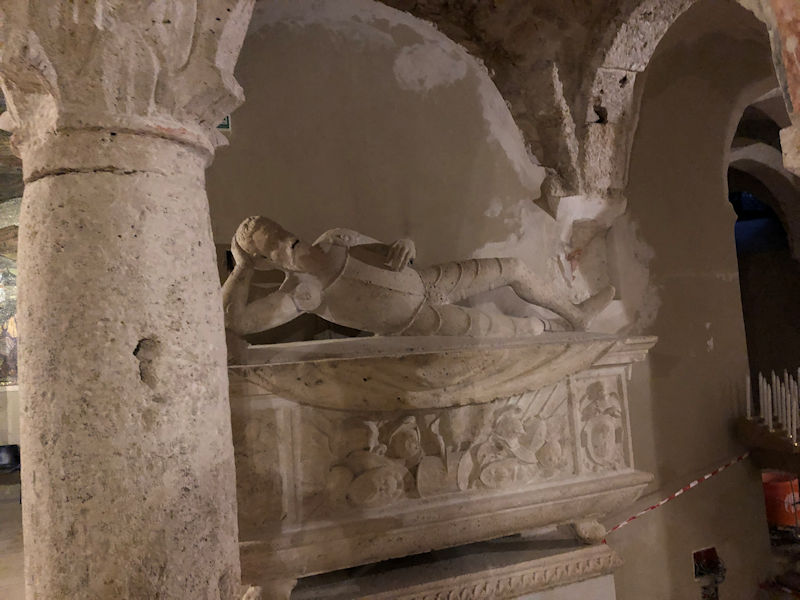
According to Italian Wiki, there are along the walls 'funeral memorials dedicated to bishops, prelates, historians and exponents of the city nobility', as well as noblemen in their armor, it seems, that were moved down here from the upper church during 19th century restorations.

The crypt specialists' work is never done.
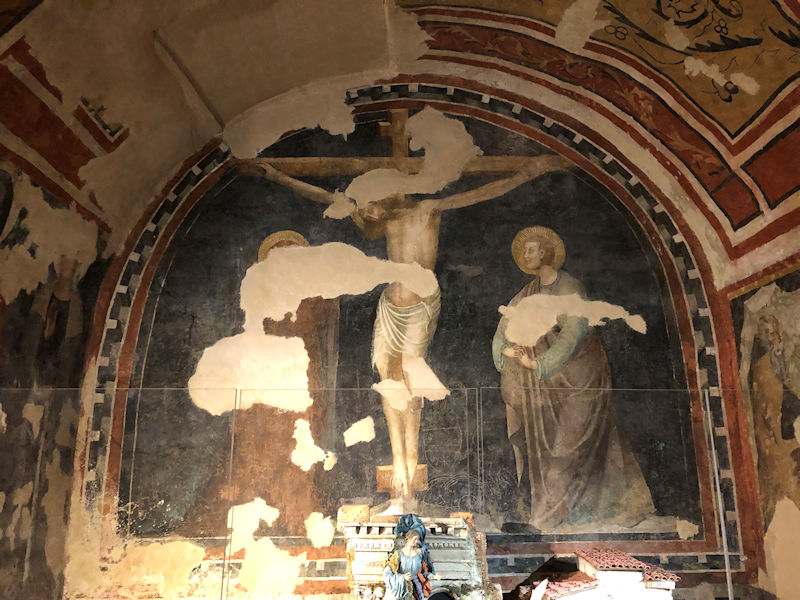
'Fourteenth-century fresco at the base of the left tower, attributed to the Master of the Ascoli Polyptych'
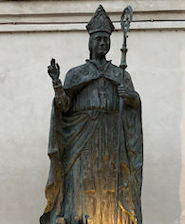 Dwight Peck's personal website
Dwight Peck's personal website


















































































